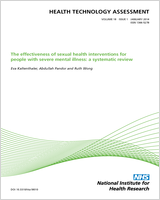Included under terms of UK Non-commercial Government License.
NCBI Bookshelf. A service of the National Library of Medicine, National Institutes of Health.
Stallard P, Phillips R, Montgomery AA, et al. A cluster randomised controlled trial to determine the clinical effectiveness and cost-effectiveness of classroom-based cognitive–behavioural therapy (CBT) in reducing symptoms of depression in high-risk adolescents. Southampton (UK): NIHR Journals Library; 2013 Oct. (Health Technology Assessment, No. 17.47.)

A cluster randomised controlled trial to determine the clinical effectiveness and cost-effectiveness of classroom-based cognitive–behavioural therapy (CBT) in reducing symptoms of depression in high-risk adolescents.
Show detailsBackground
Depression is common in adolescents, with cumulative rates indicating that up to 20% of young people will suffer at least one clinically depressive episode by the age of 18 years.1 Adolescent depression causes significant impairment, impacts on developmental trajectories, interferes with educational attainment and increases the risk of attempted and completed suicide as well as major depressive disorder in adulthood,2–5 yet it often remains unrecognised and untreated.6,7 Depression in adolescence is an important public health issue and there has been growing interest in the development of preventative and early interventions. Systematic reviews of programmes designed to reduce symptoms of depression in adolescents have noted considerable variability in results but remain supportive of prevention and early intervention approaches delivered in schools.8,9 However, significant methodological shortfalls, limited follow-up and absence of attention control or placebo comparisons have been noted as important omissions in previous studies10 and the cost-effectiveness of school-based depression prevention programmes has not yet been established.
Several evaluations have been carried out of depression prevention programmes based on cognitive–behavioural therapy (CBT) principles, including the Penn Resiliency Programme,11,12 Coping with Stress,13 Problem Solving for Life,14 FRIENDS,15 Resourceful Adolescent Programme (RAP)16 and other CBT programmes.17 Although a number of studies have demonstrated short-term reduction in symptoms of depression, there is often an absence of long-term follow-up and where this is present effects typically diminish after 6 months.1,10,18–20 Given the limited evidence of long-term gains for depression preventative interventions, it is possible that additional booster sessions could be useful in maintaining short-term benefits. Furthermore, active interventions need to be compared with appropriate controls, including placebo conditions, to account for non-specific treatment effects and spontaneous recovery.1,8,9,18
Cognitive–behavioural therapy-based depression prevention programmes have been delivered as indicated (selective or targeted) interventions to adolescents with elevated symptoms of depression21,22 or as universal interventions to whole populations.16,23 A meta-analytic review of school-based depression prevention programmes revealed that indicated programmes typically have larger effects than universal approaches.9 However, indicated preventative interventions do not provide any input to low-risk children that would prevent symptoms developing and they encounter significant recruitment problems that severely limit their reach and potential impact.11,21,24 Universal prevention programmes provide an alternative pragmatic approach, increasing reach (recruitment rates of 67–88% reported), reducing possible negative effects of stigma and labelling and resulting in lower rates of dropout.13,14,16,25 Thus, although universal approaches might have a marginally smaller effect on symptoms of depression for individuals, they can potentially reduce far more disorders in the population as a whole.26 The question of who delivers school-based interventions also needs to be considered, as depression prevention programmes that are led by trained facilitators typically have larger effects than those led by teachers.9
Of the evaluated universal depression prevention programmes, the RAP appears particularly promising. Three studies have demonstrated a reduction in symptoms of depression relative to a control group post intervention, and all have demonstrated good reach (> 70% of the eligible population) and low attrition (< 10%),16,24,25 although sustained effects at long-term follow-up (12 months) were not assessed in two of these studies.24,25 The largest of these studies was a multisite randomised controlled effectiveness trial in Australia of RAP involving 2664 students from 12 schools.24 Of the ‘at-risk’ students, 49.1% in the RAP condition moved into the healthy category post intervention compared with 35.3% in the control group. This difference was maintained at 12-month follow-up and qualitative feedback indicated a high level of skills usage in the RAP group.24
The current project aimed to undertake a pragmatic trial to evaluate the clinical effectiveness of a universally delivered classroom-based CBT depression prevention programme implemented under everyday conditions in the UK school context. To maximise the potential for effectiveness, an efficacious programme was selected (RAP), booster sessions were offered, and the programme was delivered by trained professionals external to the school. To overcome the methodological limitations of previous studies, classroom-based CBT was compared with usual Personal, Social and Health Education (PSHE) curriculum and attention control PSHE groups, and a long-term follow-up (12 months) was included.
Objectives
- Examine the effectiveness of classroom-based CBT in reducing symptoms of depression in high-risk adolescents (aged 12–16 years) 12 months from baseline compared with the usual school curriculum and an attention control group.
- Examine the effectiveness of classroom-based CBT compared with the control groups on the secondary outcomes on symptoms of depression, negative thoughts, self-esteem and anxiety (6 and 12 months from baseline).
- Undertake secondary subgroup analysis to investigate effect modification on symptoms of depression (6 and 12 months from baseline) according to sex, age and baseline report of school connectedness, bullying, self-harm, and alcohol and drug use.
- Assess the cost-effectiveness of the intervention in terms of reduction in symptoms of depression, health-related quality of life and cost–utility (6 and 12 months from baseline).
- Undertake a process evaluation to assess factors associated with adherence, acceptability and sustainability of the intervention (post intervention).
- Introduction - A cluster randomised controlled trial to determine the clinical e...Introduction - A cluster randomised controlled trial to determine the clinical effectiveness and cost-effectiveness of classroom-based cognitive–behavioural therapy (CBT) in reducing symptoms of depression in high-risk adolescents
Your browsing activity is empty.
Activity recording is turned off.
See more...